This page contains affiliate links. Please read our disclosure for more info.
Travelling carry-on only is possible whether you are away for a week or a year. We’ve been on the road for eight years with just one carry-on backpack each and wouldn’t travel any other way.
In this post you’ll learn how to travel with just a carry on in 10 simple steps based on our many years of experience.
The Benefits of Carry-On Travel
- Save time at airports – If we check in online, we avoid check-in desk queues, and when we arrive we head straight out the airport without waiting at the baggage carousel.
- Save money – We avoid airline fees for checking in luggage, which are becoming more common and can cost $25 or more per bag.
- Reduce stress – Life with less is simpler. On hectic travel days, we only have one bag to keep track of, and it’s easy to walk around looking for accommodation or getting to the bus station.
- More security – We don’t have to worry about airlines losing our checked baggage, and we can keep our luggage close on buses and trains—it’s safer by our feet than in storage compartments.
- More freedom – It’s liberating to realise how little we really need. We don’t feel burdened by our stuff—by travelling with just a backpack we can pack up in ten minutes and head off on our next adventure.

10 Steps to Carry-On Only Travel
1) Choose Carry-On-Size Luggage
Start by choosing luggage that is within most airlines’ size restrictions. The most commonly allowed size of carry-on luggage is 56 x 36 x 23 cm (22 x 14 x 9 inches), although some budget airlines only allow smaller bags.
We prefer to travel with a backpack as it keeps our hands free, and we can move around easily without having to drag a suitcase up stairs or over cobblestone or dirt streets.
Around 40 litres is a good size for a carry-on backpack. Simon uses the Tortuga Setout and I have the Osprey Farpoint 40—read our detailed review here.
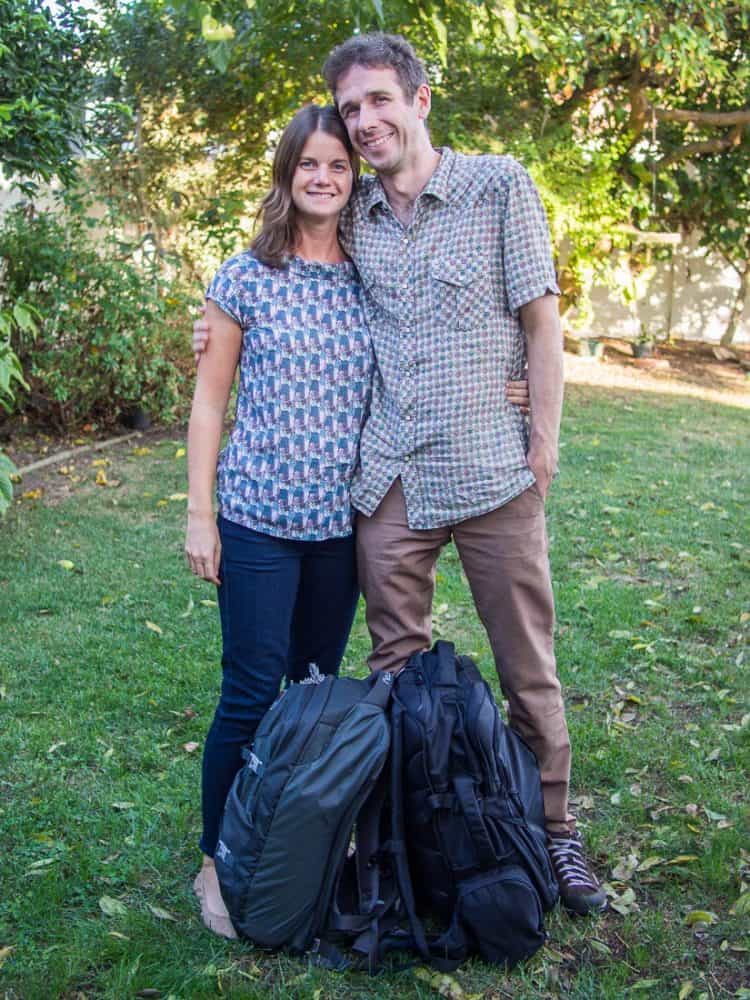
If you have any back issues (or just don’t like backpacks), a suitcase is a better option. For long term travel, look for a suitcase with rugged wheels to navigate rough terrain. A soft-sided case will weigh less and can be squeezed into smaller spaces. The Osprey Ozone 22″ is a popular option.
Most (but not all) airlines allow an extra small bag or personal item in addition to your main bag. We find it easier to travel with just one backpack each.
We also have a light packable daypack that packs inside Simon’s backpack on most travel days. When we need something more robust for a long hike, we empty out my backpack and use that.
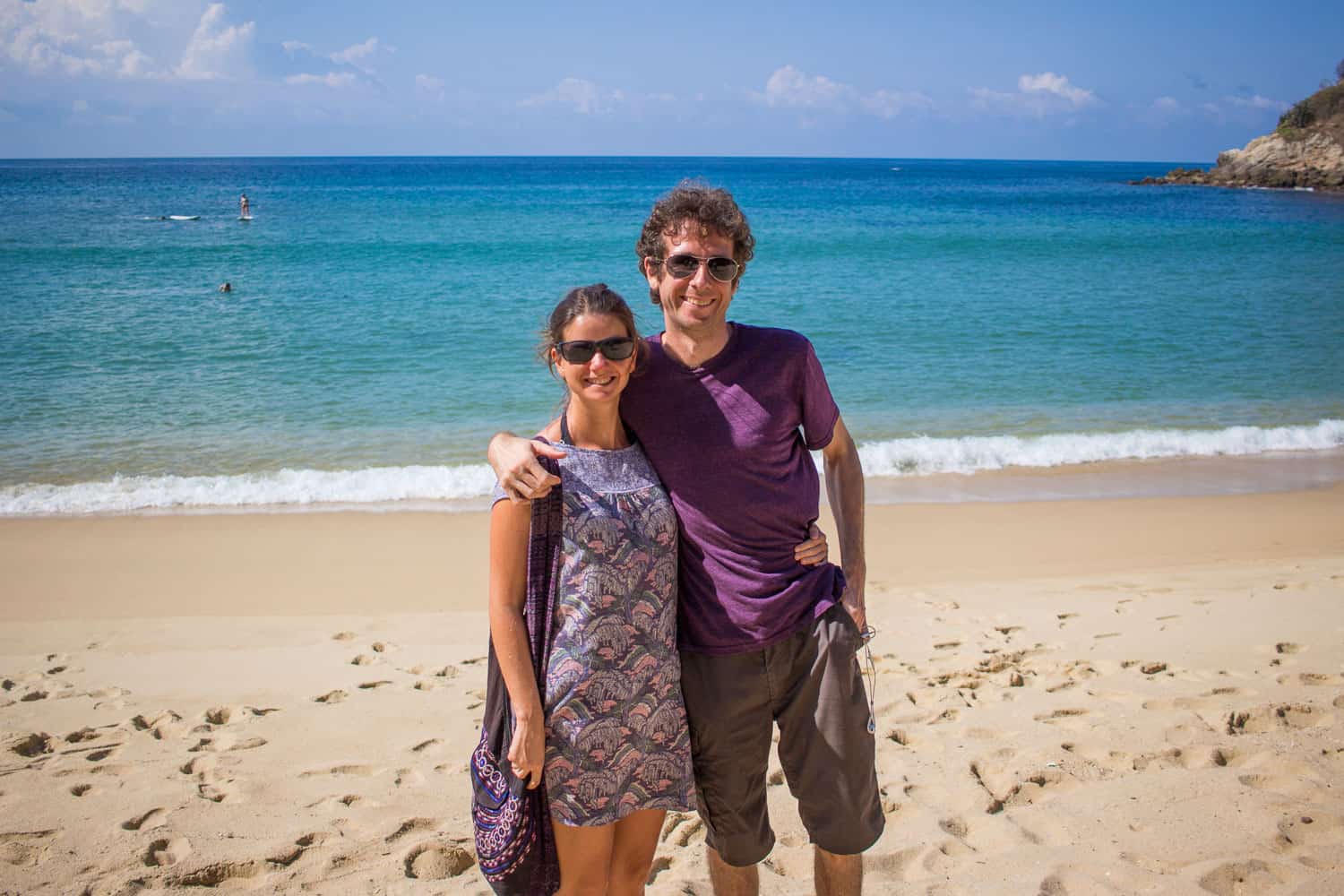
2) Pack for a Week
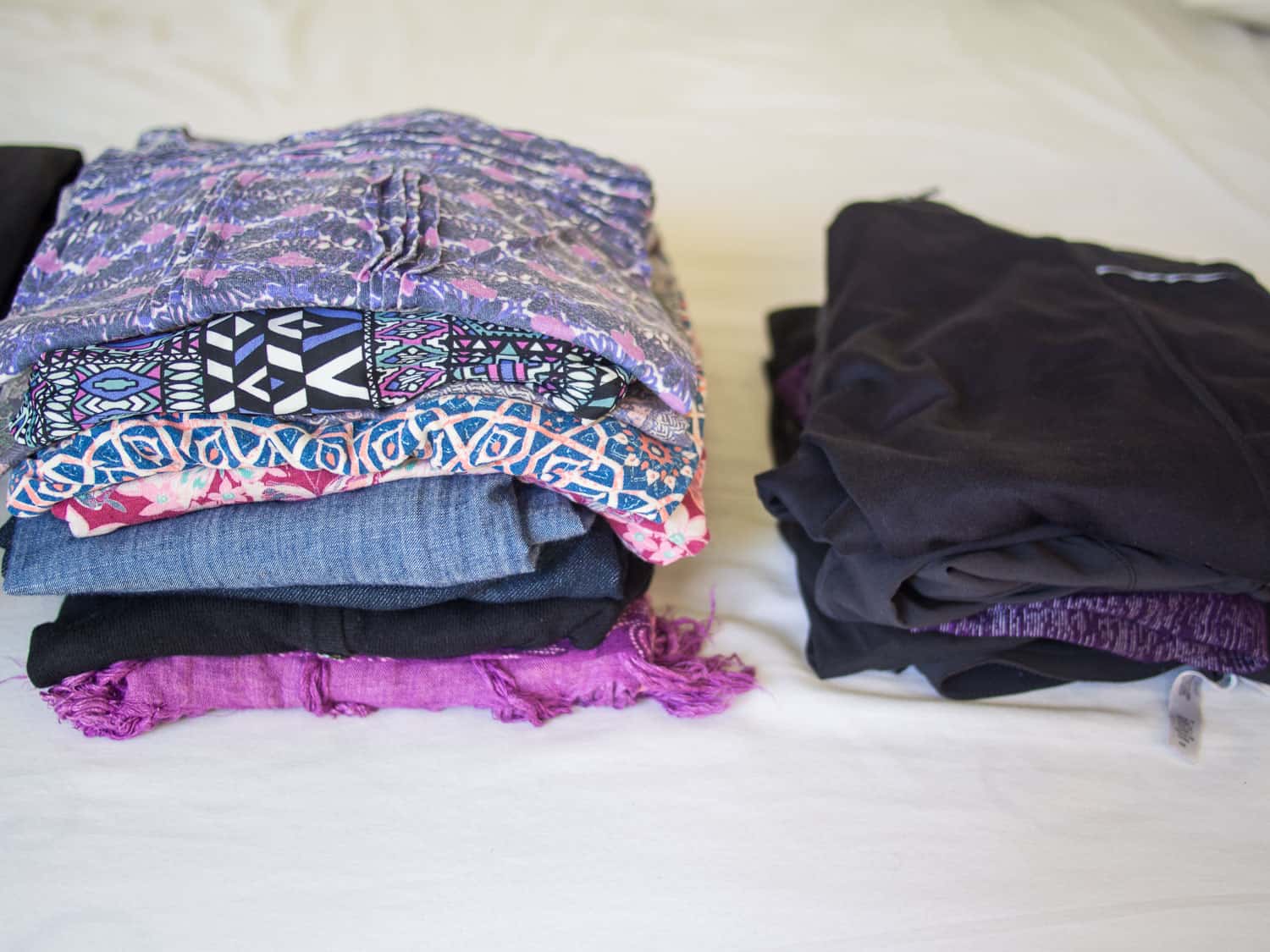
It doesn’t matter whether you are travelling for a week or a year (or 8+ like us!)—only pack enough clothes for a week and then do laundry.
Laundry services are inexpensive in many parts of the world—in Southeast Asia and Latin America, we typically pay $1 per kilo. Or we hand wash clothes in a sink (I use the hotel shampoo or shower gel), or rent Airbnb apartments with washing machines.
Choose lightweight, quick-drying fabrics for your travel wardrobe. Make sure all your clothes can be worn together so that you can mix and match and create multiple outfits. 10-12 items of clothing and 2-3 pairs of shoes is usually enough. You can use accessories to change things up.
3) Use Packing Organisers
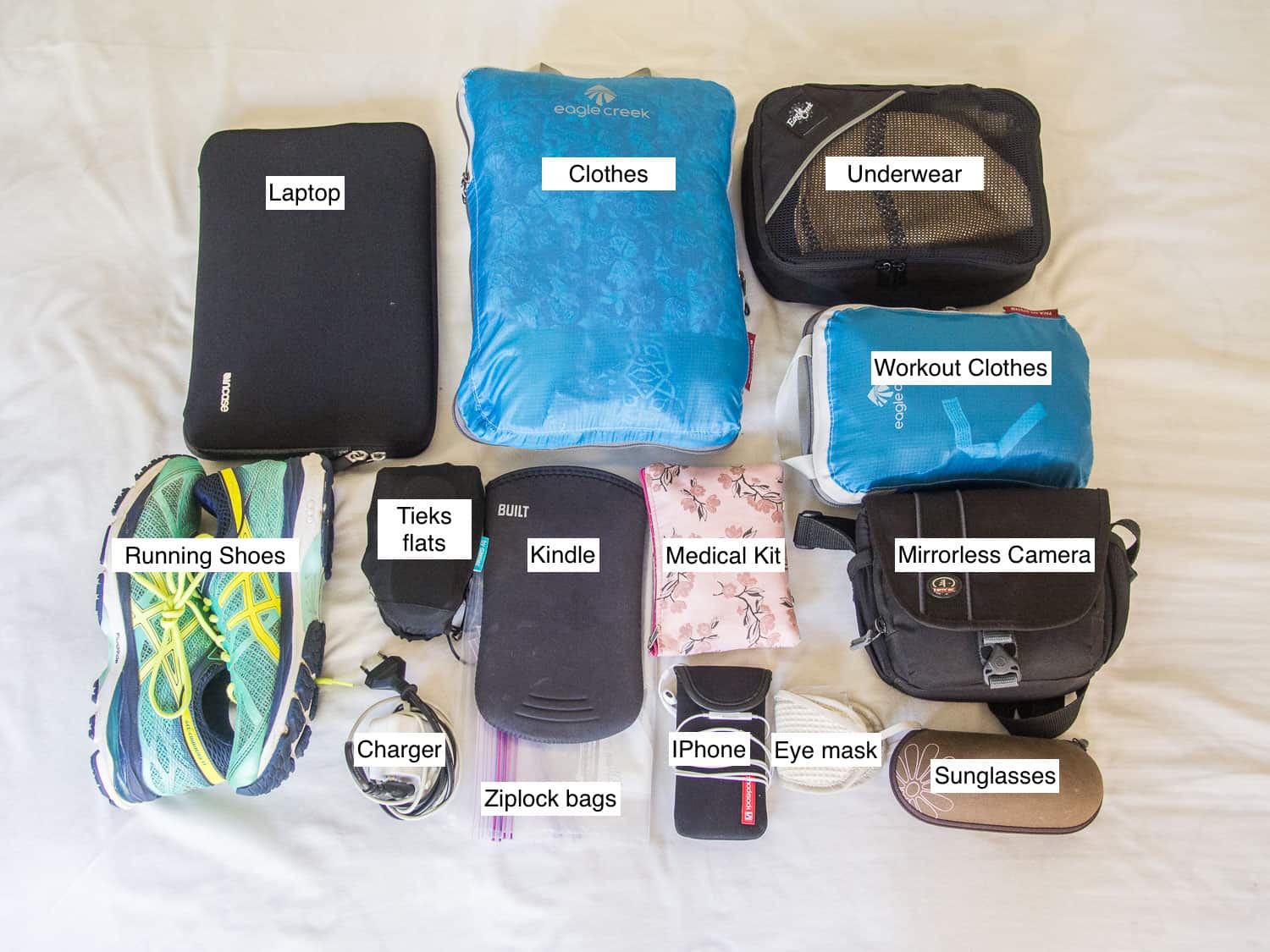
Packing cubes or compression bags allow you to keep your things organised and fit way more into your luggage. Almost every carry-on traveller I know swears by them.
Read more about how to use packing cubes to save space.
4) Pack Solid and Long Lasting Toiletries
On flights, you can only bring liquids in bottles of 100 ml (3.4 oz) or less, and they must fit into a one-litre (or one-quart) zip-lock bag per person.
To manage this restriction, choose solid toiletries whenever possible. Lush shampoo bars are fantastic, and we use a natural crystal deodorant that lasts forever. You can also find solid perfume, lotion, sunblock, and more.
Look for long lasting toiletries so that you don’t need to pack as much. We love Riemann once a day suncream, and a tiny bottle of shaving oil lasts Simon nine months.
A mooncup takes up less space than tampons, is better for the environment, and you don’t have to worry about finding sanitary products abroad.
5) Choose Small Alternatives
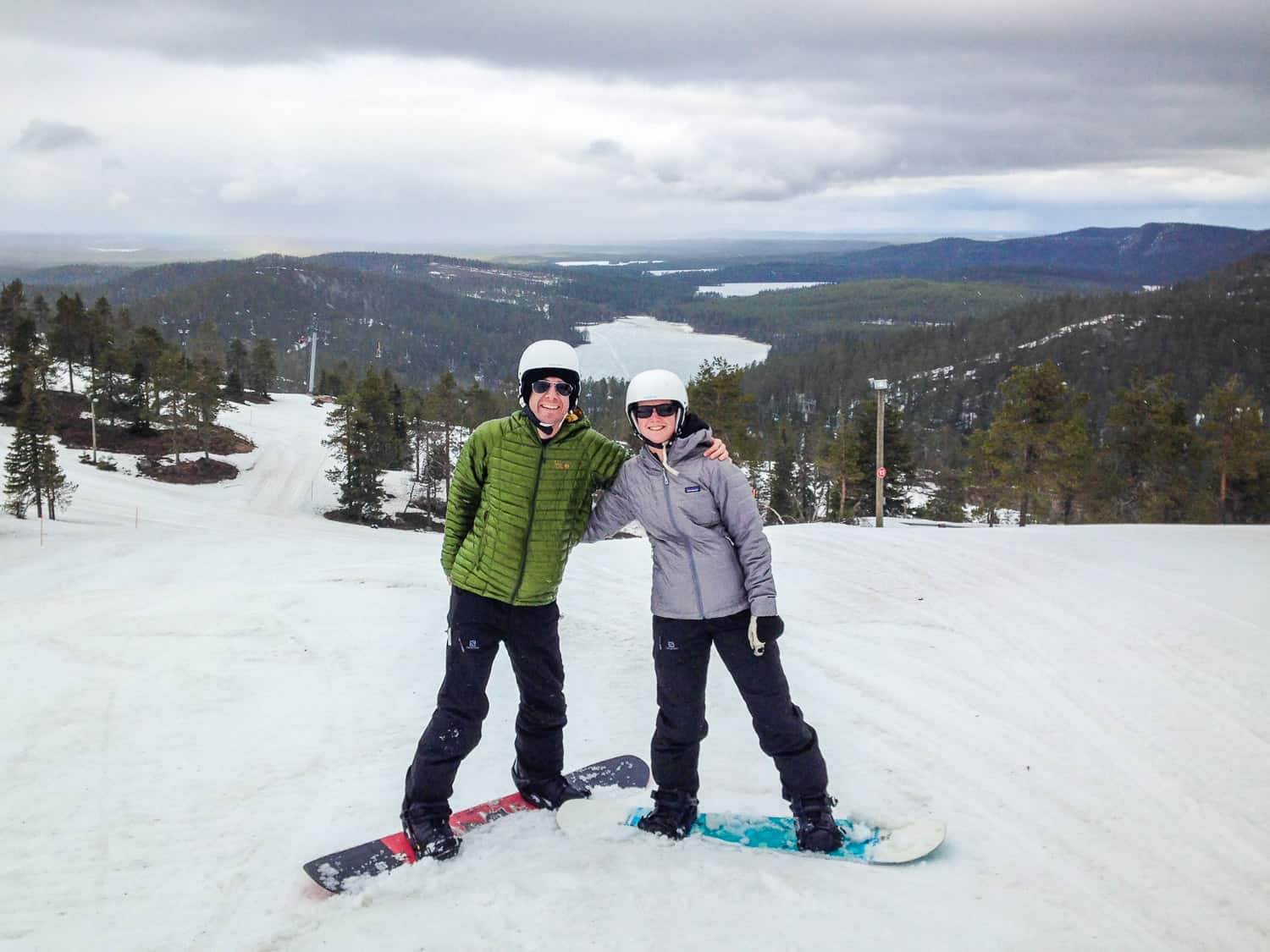
Whatever you want to pack, you can usually find a lighter, more compact version. Travel and outdoor gear is often lighter and less bulky than regular clothes.
- In South America, my water-resistant windbreaker compressed to the size of an apple and weighed almost nothing.
- On a Finland ski trip, my ultralight down jacket kept me warm but packed down small.
- A microfibre travel towel is smaller, lighter, and dries more quickly than a regular towel.
- My Tieks ballet flats are stylish and comfortable but fold down to a tiny size (read my review of these comfortable flats).
- Simon’s Bluffworks trousers are lightweight and quick-drying but attractive enough for every occasion (read his Bluffs review).
- My YogaPaws are way smaller and lighter than a yoga mat but stop me slipping on any surface (read my YogaPaws review).
6) Go Paperless
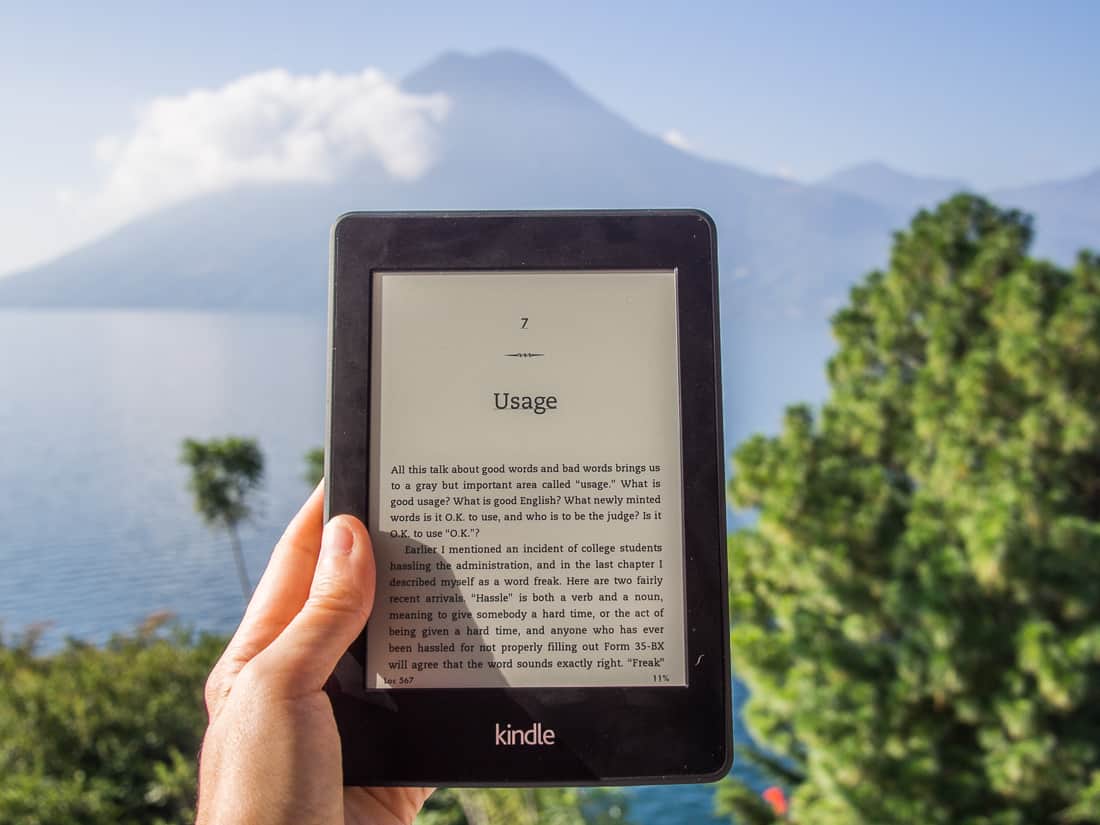
Paper is heavy so avoid it if possible. A Kindle or other e-reader is a must for travelling bookworms—you can fit thousands of books on a device smaller than one paperback.
I couldn’t live without my Kindle Paperwhite. If you only read occasionally, you could use your smartphone or tablet instead (which is what Simon does).
Simon has also gone entirely digital with his artwork and now does all his drawing on the iPad Pro with the Apple Pencil, which replicates a real pen or brush.
7) Minimise Electronics
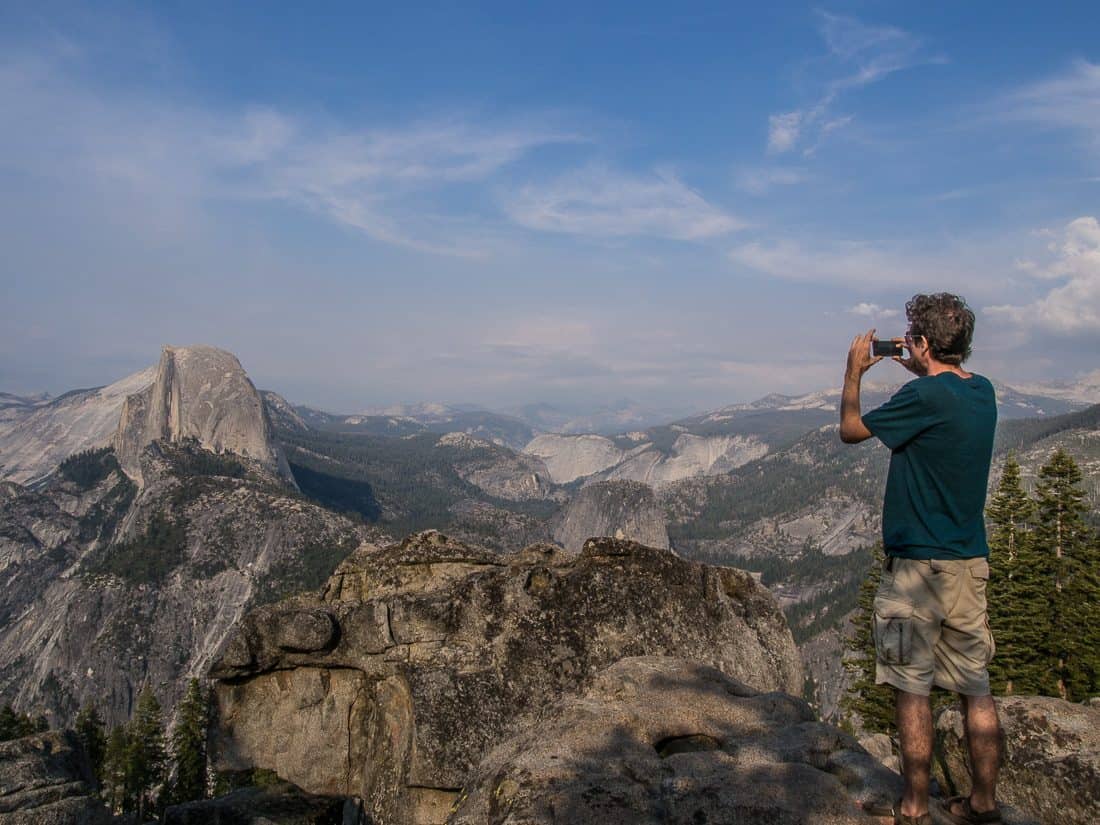
We travel with a lot of electronics as we work on the road, but most travellers don’t need a laptop—a smartphone or tablet can work just as well and take up far less space.
Unless you are really serious about photography, a smartphone takes great photos and is multipurpose. As I need quality photos for this blog, I’ve found that a mirrorless camera is a good compromise—it’s much smaller than my old DSLR. I often just use our iPhone 6 though.
Save space by sharing power cables between devices and with your partner if you are travelling with someone.
8) Don’t Pack Anything “Just in Case”
I recommend creating a packing list and doing a test pack at least a few days (more for long trips) before you leave. Lay everything out and ask yourself what you plan to use it for. If it’s for a “just in case” scenario, then ditch it. Everything needs to earn its place in your bag by being used regularly.
In eight years of travel, we have never needed a sleeping bag, sleep sheet, mosquito net, washing line, travel sink plug, travel pillow, door stop, collapsable bowl, or many of the other items on travel packing lists. We also haven’t missed travelling with a penknife (which isn’t allowed on planes).
Remember that if you do find that you really need something, you can always buy it at your destination. Other places have stuff too!
9) Wear Your Bulkiest Clothes on Travel Days
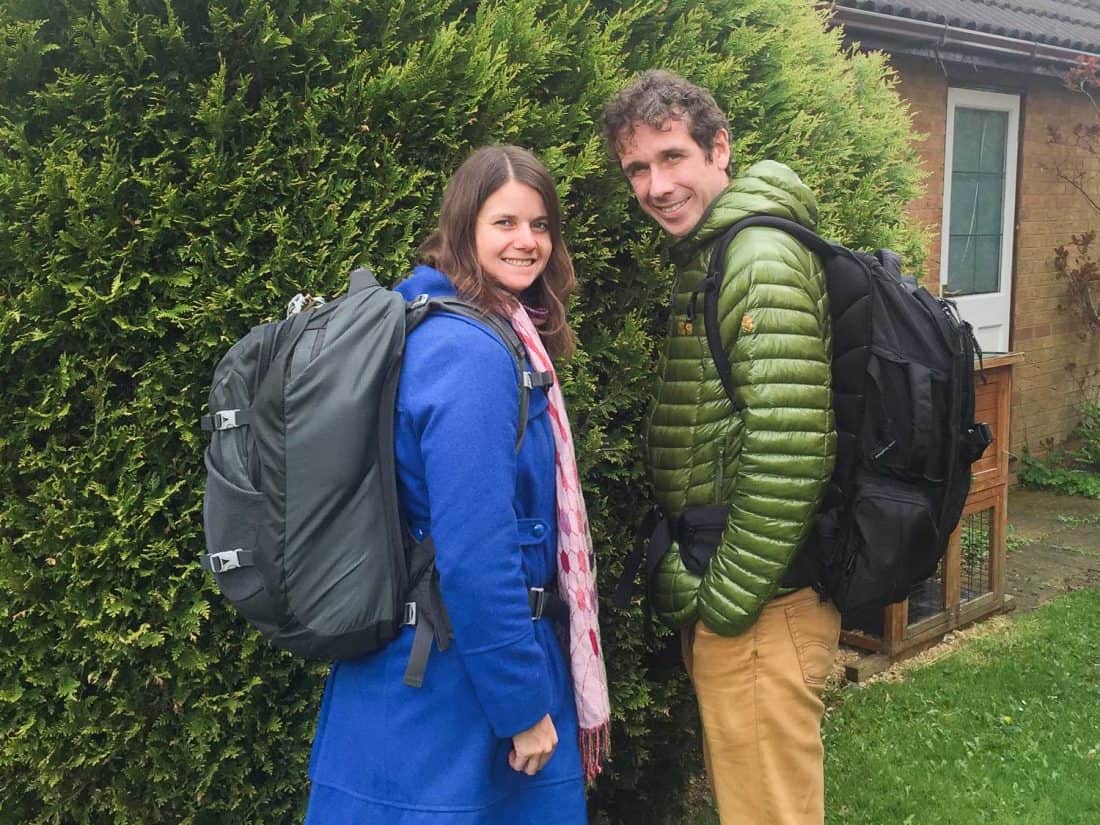
Wear your bulkiest clothes, such as hiking shoes, jeans, and sweaters, on travel days to save space and weight in your luggage. This is especially important when flying on airlines with a low carry-on weight allowance and when travelling to cold climates with bulky winter clothes.
This strategy is trickier in hot countries if you are travelling on transport without air conditioning or walking in the heat to find accommodation. In this case, make sure all your clothes fit in your bag even when you’re wearing a lightweight outfit.
10) Prioritise
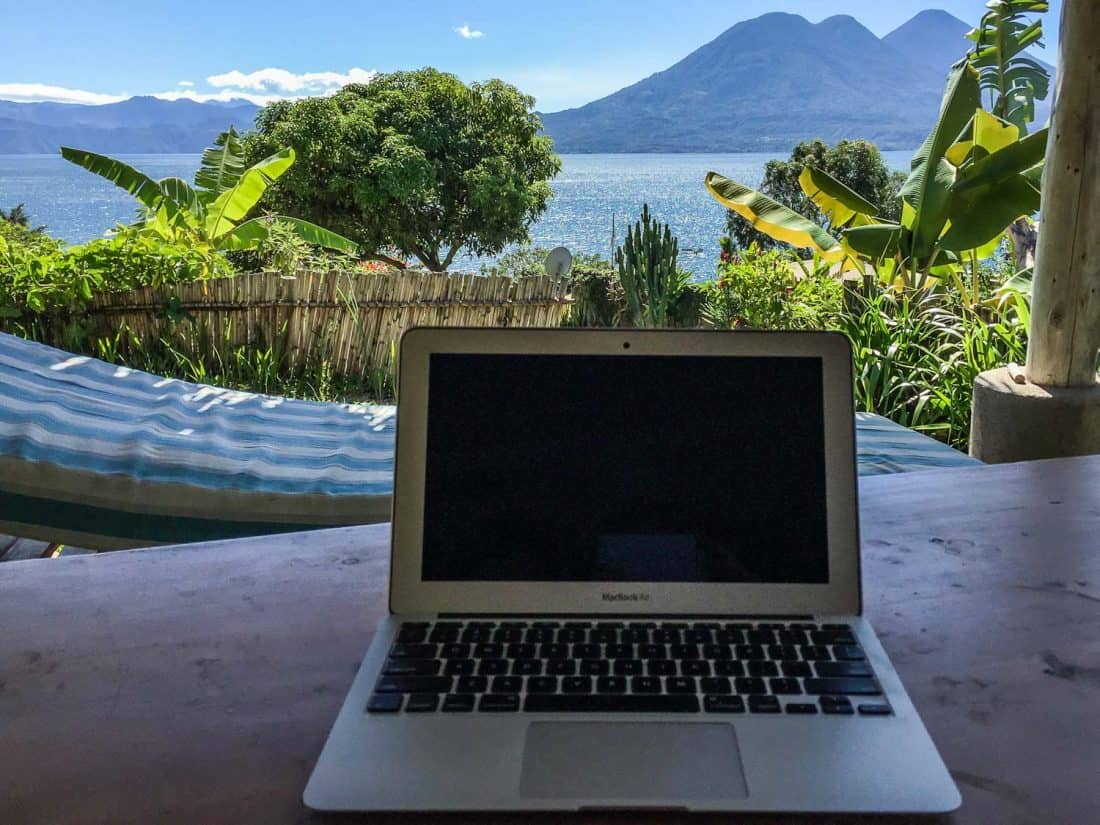
Ultimately, travelling carry-on only comes down to priorities. What is most important to you? We travel with a ton of electronics as we need them for work. You might prefer to skip the laptop and take extra clothes and makeup instead.
Even carry-on travellers have space for luxuries. Simon recently started travelling with an AeroPress coffee maker. Other travellers we know pack a full-size feather pillow, yoga mat, hairdryer, or oil paints. As long as it’s something you will really use, you can make space for it.
Hopefully, by following these basic principles you’ll find a way to make carry-on travel work for you, whatever type of trip you are heading off on. I promise it will make your travels so much easier.
More Carry-On Travel Packing Tips
If you’d like to learn more about how to travel carry-on only, see my book, The Carry-On Traveller: The Ultimate Guide to Packing Light, which is available for the Kindle or paperback on Amazon (US only).
You can also see our other posts about packing light:
- Our Updated Carry-On Packing List
- The Best Carry-On Backpack for Digital Nomads
- Understanding Airline Size and Weight Restrictions
- A Ski Trip Packing List Carry-On Only
- How to Pack Carry-On Only for Cold Weather
- How to Use Packing Cubes to Save Space
If you enjoyed this post, pin it!

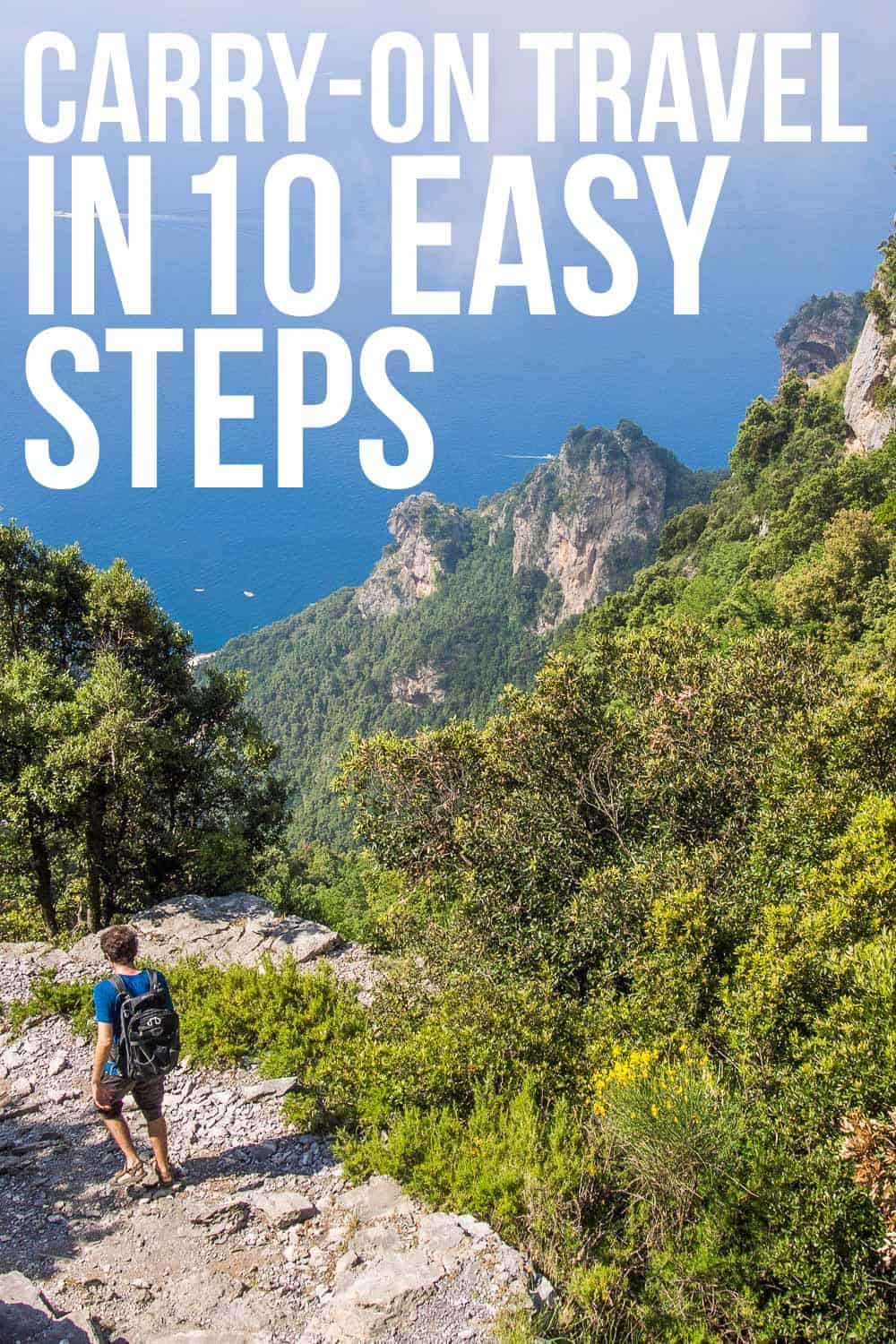

I’ve been a carry-on only traveller (when I do get to go on an adventure) for the past 4 years. I started with a full size rolling suitcase and gradually worked through what I use and don’t use until I purchased the Tom Bihn Aeronaut 30 and now use that as my main travel bag. I usually pair it with a tote bag or my Tom Bihn Sidekick because I like to have my Sony mirrorless camera and passport at my side rather than on my back.
It’s just so much less stressful to travel this way. The first time I travelled solo, my flight was cancelled after I reached my gate and I was rebooked at a different airport across town. Everyone around me was panicking about their checked bags, but I just reloaded my metro card and went on my way to the other airport. I never felt vulnerable travelling by myself because my bag was small enough to tuck between my knees while on public transit. So much freedom and peace of mind.
I also found that wearing only men thong while traveling saves tons of space versus packing boxer briefs. Once you get use to then is like wearing nothing. Probably not for everybody but tell, trust me, big time space saver.
Good tip! Sadly Simon is not keen :)
Just curious, but where is the photo from “10) Prioritise” taken? It’s a very cool location! :)
It’s San Marcos village at Lake Atitlan in Guatemala. It is a beautiful, relaxing place! Here’s our post about it: https://www.neverendingvoyage.com/temporary-home-lake-atitlan-guatemala/
I forgot to add, I’m also planning on climbing a mountain (yellow mountain, in china) and leaving my luggage at the base in storage for a night, which also seems tricky to do when I only have 1 backpack/carry-on.
I’m planning on traveling to Peru and China soon, and am interested in getting a travel backpack instead of a wheeled carry on. My dilemma is, what to do when you’re out hiking for a day and need a backpack, but don’t want to lug all the weight of your stuff with you. If I’m just walking around a city, a large purse fits my needs perfectly, but it’s not ideal for hiking. Do you ever find yourself wishing you had a “luggage” bag and a dedicated backpack?
We actually have just bought a packable daypack which is working out really well. It fits in Simon’s main backpack on travel days but we take it out for hikes when needed. We tried a few and bought this one by Gonex: http://amzn.to/2kuQIOu
Fair play! I’ve been doing exactly this since my late teens / early twenties when I read in a travel book that when you’ve finished packing your bag it’s best to remove half the stuff and take twice the money. My now wife was very sceptical when I told her that I’d leave her at the baggage carousel if she took check in but she’s now firmly converted.
People seem to forget that where there’s an airport (etc) there’s a shop. I live in the UK and the shops here are always more expensive than wherever I end up. I’m now pretty much convinced that people large quantities of their personal effects with them as a memento of their home because they feel insecure. They fear the unknown. The larger the luggage the more insecure the person.
Top tip – for airlines that restrict carry on ridiculously, I’ve been on flights where it’s 3kg, just wear all your clothes! Airports and planes usually have aircon after all :)
Hey!
Great tips. I was wondering how you bring mosquito repellent when you’re going to countries infested with malaria? Do you buy it there? Are there any efficient repellents in southeast Asia?
We usually just buy it there when we need it. Or you could just buy a bottle under 100ml.
Save time in the airports that a true you save alot of time
Hi. Can you tell me please, what is the weight of your carry-ons?. Including laptop, kindles, camera and chargers? We fly around Europe on budget airlines a lot ( we live in Romania, we’re British/Australian full time travellers) and our hand baggage is ALWAYS over-weight. Even though we also check our big backpacks! (they rarely check because we have small backpacks not wheelie bags). The weight limit on the airlines we use for carry-on is tiny. Our laptops, kindles, chargers a lush shampoo bar ( my only luxury!) and cameras basically take up all that weight. There is room for maybe one change of clothes and toothbrushes, if that. I’d be interested to know how you weigh in. Do you use mini-laptops? We also work online, the electronics are the killer. By the way, love your colour scheme, TARDIS blue :)
My bag is 8-9kg and Simon’s is around 10kg, so yes, we are often overweight. You can see exactly what we pack in our updated packing list: http://www.neverendingvoyage.com/the-carry-on-traveller-book/
We travel in Europe and Asia a lot where the weight limits are low. But they never weigh our bags! In my book, I’ve written about how we avoid this, but my main tip is to check in online to avoid the desk.
Congratulations on your book! I am always impressed by your strict minimalism, and your writing is always very clear, detailed and informative – thank you! As for me I am not quite where I need to be on the minimalism scale! My partner and I have been travelling full-time for nearly 3 years in a camper-van and have MUCH more stuff than you guys! I am ‘home’ in the UK at the moment trying to finally empty our storage unit and only keep things that come with us aboard our van – but I find it so hard! And have a real problem with my clothes! Eek!
I wonder, do you have any ‘stuff’ stored somewhere or did you get rid of everything? And, did you also find the process of letting go hard like me?
Thank you Wendy! At least with a van you don’t need to pack quite as light.
We left two small boxes at Simon’s mum’s house with some photo albums and a few sentimental things, and we keep one small box at my parent’s house with warm clothes for when we’re in the UK (which is COLD for us even in the summer!). Everything else we got rid of. It was difficult at first, but it gets easier as you go along. Start with things you find easy to get rid of. Also remember you can take photos of any sentimental items. We honestly haven’t missed anything we sold/donated (and haven’t even looked in our boxes in 6 years so probably could have got rid of those too). Good luck with it!
Very useful.
Nice post….I have been following your blog for about a year and this will help with packing for my upcoming getaway! Good job on the book and useful software …. nice to see you both successfully fullfiling your dreams and inspiring us all.
Thank you very much Mark and enjoy your trip!